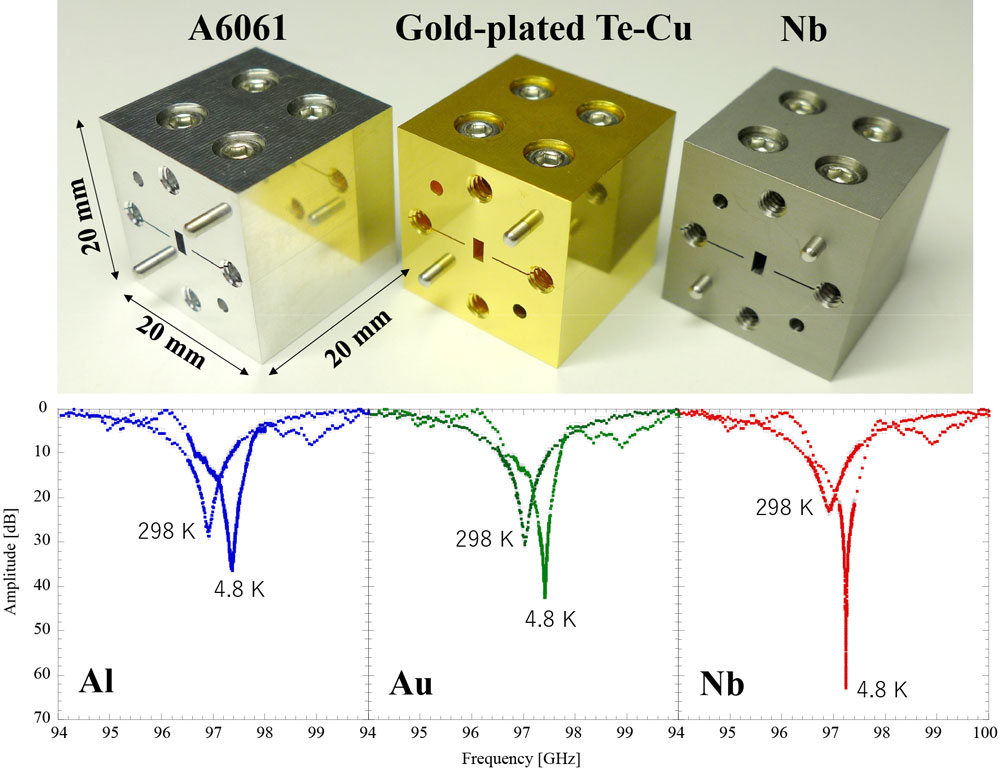ED5-2-INV
Propagation in Superconducting Niobium Rectangular Waveguide in the 100 GHz band
Nov. 30 15:25-15:50
*Tac Nakajima1, Kazuji Suzuki1, Takafumi Kojima2, Yoshinori Uzawa2, Masayuki Ishino3, Issei Watanabe4
Institute for Space-Earth Environmental Research, Nagoya University, Japan1
National Astronomical Observatory of Japan, Japan2
Kawashima Manufacturing Co., Ltd., Japan3
National Institute of Information and Communications Technology, Japan4
Receivers of a radio telescope for astronomy and atmospheric radiometer for earth science in the millimeter/sub-millimeter bands are usually used complicated waveguide circuits such as a sideband-separating unit (e.g. Claude et al. 2000), an ortho-mode transducer (e.g. Moorey et al. 2006), and a multiplexer (e.g. Kojima et al. 2017). However, if these waveguide components are placed before the superconducting tunnel junction device (SIS mixer) or HEMT amplifier, which is the first detector in the receiver system, the system noise increases due to the transmission loss of the waveguide circuit. This effect is a serious problem, especially in the sub-millimeter and the terahertz-wave band. Even in the international radio astronomical observatory project namely the Atacama Large Millimeter/sub-millimeter Array (ALMA) multiband receiver covering 35 to 950 GHz, the dual polarization and sideband-separating receiver based on waveguide technique is a limited frequency range of up to 500 GHz. Above this frequency, waveguide components placed in front of the detector are being developed with an emphasis on how to avoid transmission loss.
Rectangular waveguides that use superconducting materials for the waveguide walls, that is, superconducting waveguides, are expected to reduce transmission loss compared to normal metal waveguides. However, research on the superconducting waveguides has been limited so far, especially on the fabrication and measurement of physical models in the mm/sub-mm band. For this reason, the effectiveness of superconducting waveguides in reducing transmission loss and system noise has not been clarified. Therefore, we have attempted to fabricate superconducting niobium (Nb) rectangular waveguide in the 100 GHz band, measure its propagation characteristics, and verify its effectiveness.
In this work, the resonator method is adopted for the measurement of waveguide propagation because accurate measurement of a short waveguide at cryogenic temperature is quite difficult. First, we fabricated the Nb rectangular waveguide resonator in the 100 GHz band. However, Nb is known as a difficult-to-machine material, and many metal-processing companies lack experience in its fabrication. Thus, we started to search for the best cutting tools and machining conditions. As a result, we succeeded in fabricating the waveguide with a surface accuracy of 0.3 μm (RMS) using an end mill with a diameter of 1 mm. For comparison, the same waveguide resonators made of aluminum alloy (A6061; hereafter Al) and tellurium copper (with a gold finish; hereafter Au) were fabricated as representative waveguide materials (upper side of the figure).
Next, we measured those resonance characteristics at room temperature, 298 K, and cryogenic temperature, 4.8 K (lower side of the figure). The resonance properties of all materials at 298 K are almost consistent with the shapes predicted from the literature-based conductivities. On the other hand, at 4.8 K, the changes in the resonance properties of superconducting Nb are significantly larger compared to that of Al and Au. We used electromagnetic analysis software to reproduce these properties and calculated electrical conductivity and propagation loss. The conductivity of Al, Au, and Nb at 4.8 K are calculated as 5.2×107 S/m, 2.8×108 S/m, and 1.1×1011 S/m, respectively. The propagation loss of the Nb waveguide per meter is estimated as 0.06 dB/m, and this value is approximately 1/30 that of Al and 1/17 that of Au.
In this presentation, we will report details of the discussion on propagation loss and the effectiveness of superconducting rectangular waveguides.
Keywords: Superconducting Waveguide, Niobium, millimeter-wave, Radio Astronomy
